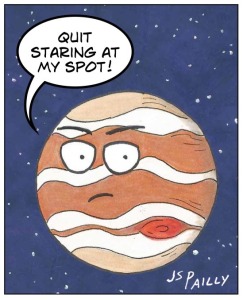Don’t let Jupiter’s stormy personality fool you. He’s all warm and fuzzy on the inside.

I have a couple more “Alien Eyes on Earth” posts on the way, but last week one of my favorite space missions was in the news: the Juno mission to Jupiter.
Now I have to confess I haven’t done a whole lot of research on what Juno’s found. I take it some of the highlights are:
- We got a cool picture of Jupiter’s rings with the constellation Orion in the background.
- Those cyclones clustered around Jupiter’s poles—those are still weird.
- It sounds like something freaky is happening with Jupiter’s auroras. I’m planning to do a separate post on that in the near future.
But the thing that really grabbed my attention was this: Jupiter’s core is being described as “fuzzy.” I’m not sure how to visualize that, but it’s also being described as “partially dissolved,” which makes a little more sense to me.
We know about this because Juno is gravity mapping the planet—using highly precise measurements of Jupiter’s gravitational field to determine how mass is distributed in the planet’s interior.
We also know about it thanks to Juno’s magnetometer. Planetary magnetic fields are generated by an internal dynamo effect, the result of all that pressurized liquid metal swirling and churning around a planet’s core. But according to Juno’s magnetometer, it seems Jupiter’s magnetic field is not what we expected, which suggests… what? Multiple dynamo effects? A big dynamo in the middle with smaller dynamos surrounding it?
Again, I haven’t done any proper research about this. Not yet. But I had a thought that I wanted to throw out there: we never figured out why Neptune’s magnetic field is so out of whack.

So now I’m wondering if there could be a connection there. Could weird, confusing, complicated magnetic fields just be a common feature of gas giants?
Also, the Sun has a wildly complex tangle of magnetic field lines around it. Might there be a relationship between the weird magnetic fields of gas giant and the weirder magnetic fields of stars?
I don’t have any answers. I’m just speculating after all the Juno news last week. It’ll be interesting to see what Juno tells us next.
On Thursday, we’ll get back to those aliens studying Earth from a distance.
Links
Jupiter Surprises in Its Closeup from Science Friday.
Jupiter Data from Juno Probe Surprises Scientists from Solar System Digest.
Jupiter Surprises in First Treasure Trove of Data from NASA’s Juno Mission from Spaceflight Now.
Sounds super interesting. I’d really love to know what’s going on in there. The idea that a larger mass object might have increasingly more erratic magnetic fields is curious.
LikeLiked by 1 person
It’s just a thought I had when I heard the news. Don’t know if there’s any validity to it, but it kinds feels like a trend to me.
LikeLike
A larger object can contain more information than a small one. Maybe the larger a body is, the higher is its potential for complexity. If there is a source of energy, complex dissipative systems should form, so maybe it was naive to expect Jupiter’s interior to be simple.
LikeLiked by 1 person
I agree. I was sort of surprised by articles saying scientists “expected” Jupiter’s interior to be simple. Before Juno arrived, I read a lot about how scientists thought Jupiter’s interior would probably be complicated. I guess it’s another case of there being two competing schools of thought, and now one of those schools of thought can be ruled out.
LikeLiked by 1 person
I believe scientists have drilled a huge ter massive hole on our planet Earth to find out what lies within. Someone speculated hell lies beneath the surface. who knows what kind of life awaits us on Jupiter. We could be in for a shock someday, once we become supremely proficient with our technological gizmos
LikeLiked by 1 person
I seem to remember Isaac Asimov wrote some interesting things about life on Jupiter. Something about fish-like creatures swimming through the atmosphere.
LikeLike
Wow… great post. Now I have to go back and read more about the fuzzy core. I’ve missed that in the reading and writing I’ve done. Sigh…
LikeLiked by 1 person
The segment on Science Friday was what really got me excited about that. They didn’t go into any real detail, but they said enough to get me thinking.
LikeLiked by 1 person
Science Friday’s great… yeah… my mind’s spinning a little now, too.
LikeLiked by 1 person